New Age Constraints of the Bilong Co Oil Shale in the Qiangtang Basin, Northern Tibet: Evidence from In Situ U–Pb Dating and Palaeontology
Abstract
1. Introduction
2. Geologic Setting
3. Material and Methods
3.1. Samples
3.2. Petrography and Palaeontology
3.3. LA–MC–ICP–MS U–Pb Isotope Analyses
3.4. Element Analyses
4. Results
4.1. Ammonites
4.2. U–Pb Geochronology
4.3. Elemental Geochemistry
5. Discussion
5.1. Age Constraints Based on Bio-Chronological Data
5.2. Calcite U–Pb Geochronology
5.2.1. Primary Depositional Age
5.2.2. Age Assessment Based on Radioisotopic Dates
5.3. Significance of the New Geochronology in the Bilong Co Section
Reconstruction of the Chronostratigraphic Framework in the Bilong Co Section
- Pre-Toarcian
- Toarcian
- Aalenian
- Bajocian
- Bathonian
- Callovian
5.4. Regional Chemostratigraphic Correlation and Implication for the Quse Oil Shale Age
6. Conclusions
- (1)
- The previous investigations of age estimates are supported by the new in situ carbonate U–Pb isotope dating, suggesting that the Quse oil shale in the Bilong Co area was deposited during the Early Jurassic.
- (2)
- Newly discovered age-diagnostic ammonite assemblage revealed that the age constraint for the Bilong Co oil shale is the early Toarcian, rather than the previous suggestions of a Middle Jurassic age.
- (3)
- Regional correlation of in situ carbonate U–Pb isotope dating along with marker ammonites, bivalves, and calcareous nannofossils from adjoining sedimentary sections in the Bilong Co area provide further evidence of an early Toarcian age of the oil shale strata.
- (4)
- New geochronologic results and regional correlation of N-CIE indicate that the Quse oil shale provides a record of the global T-OAE in the eastern Tethys generally and the Qiangtang Basin particularly. This result provides new significance of further regional evaluation of source rocks in the Qiangtang Basin.
Supplementary Materials
Author Contributions
Funding
Data Availability Statement
Acknowledgments
Conflicts of Interest
Correction Statement
References
- Hesselbo, S.P.; Jenkyns, H.C.; Duarte, L.V.; Oliveira, L.C.V. Carbon-isotope record of the Early Jurassic (Toarcian) Oceanic Anoxic Event from fossil wood and marine carbonate (Lusitanian Basin, Portugal). Earth Planet. Sci. Lett. 2007, 253, 455–470. [Google Scholar] [CrossRef]
- Remírez, M.N.; Algeo, T.J. Carbon-cycle changes during the Toarcian (Early Jurassic) and implications for regional versus global drivers of the Toarcian oceanic anoxic event. Earth-Sci. Rev. 2020, 209, 103283. [Google Scholar] [CrossRef]
- Ruebsam, W.; Piénkowski, G.; Schwark, L. Toarcian climate and carbon cycle perturbations—Its impact on sea-level changes, enhanced mobilization and oxidation of fossil organic matter. Earth Planet. Sci. Lett. 2020, 546, 116417. [Google Scholar] [CrossRef]
- Cohen, A.S.; Coe, A.L.; Harding, S.M.; Schwark, L. Osmium isotope evidence for the regulation of atmospheric CO2 by continental weathering. Geology 2004, 32, 157–160. [Google Scholar] [CrossRef]
- Montero-Serrano, J.-C.; Föllmi, K.B.; Adatte, T.; Spangenberg, J.E.; Tribovillard, N.; Fantasia, A.; Suan, G. Continental weathering and redox conditions during the early Toarcian Oceanic Anoxic Event in the northwestern Tethys: Insight from the Posidonia Shale section in the Swiss Jura Mountains. Palaeogeogr. Palaeoclimatol. Palaeoecol. 2015, 429, 83–99. [Google Scholar] [CrossRef]
- Fu, X.G.; Wang, J.; Feng, X.L.; Wang, D.; Chen, W.B.; Song, C.Y.; Zeng, S.Q. Early Jurassic carbon-isotope excursion in the Qiangtang Basin (Tibet), the eastern Tethys: Implications for the Toarcian Oceanic anoxic event. Chem. Geol. 2016, 442, 62–72. [Google Scholar] [CrossRef]
- Xia, G.Q.; Mansour, A. Paleoenvironmental changes during the early Toarcian Oceanic Anoxic Event: Insights into organic carbon distribution and controlling mechanisms in the eastern Tethys. J. Asian Earth Sci. 2022, 237, 105344. [Google Scholar] [CrossRef]
- Ruebsam, W.; Al-Husseini, M. Orbitally synchronized late Pliensbachian–early Toarcian carbon-isotope and glacio-eustatic cycles. Palaeogeogr. Palaeoclimatol. Palaeoecol. 2021, 577, 110562. [Google Scholar] [CrossRef]
- Xia, G.Q.; Mansour, A.; Gentzis, T.; Li, G.J.; Carvajal-Ortiz, H.; Ocubalidet, S.; Yi, F.; Yun, C.; Yi, H.S. Depositional paleoenvironment and source rock characterization across the Toarcian Oceanic Anoxic Event from the eastern Tethys, Tibet, SW China. Int. J. Coal Geol. 2021, 243, 103780. [Google Scholar] [CrossRef]
- Zhao, Z.Z.; Li, Y.T.; Ye, H.F.; Zhang, Y.W. Tectonic Characteristics and Basin Evolution of the Tibetan Plateau; Science Press: Beijing, China, 2001; pp. 93–97, (In Chinese with English Abstract). [Google Scholar]
- Wang, J.; Tan, F.W.; Li, Y.L.; Li, Y.T.; Chen, M.; Wang, C.S.; Guo, Z.J.; Wang, X.L.; Du, B.W.; Zhu, Z.F. The Potential of the Oil and Gas Resources in Major Sedimentary Basins on the Qinghai-Xizang Plateau; China Geological Publishing House: Beijing, China, 2004; pp. 167–168, (In Chinese with English Abstract). [Google Scholar]
- Wang, J.; Fu, X.G.; Wei, H.Y.; Shen, L.J.; Wang, Z.; Li, K.Z. Late Triassic basin inversion of the Qiangtang Basin in northern Tibet: Implications for the closure of the Paleo-Tethys and expansion of the Neo-Tethys. J. Asian Earth Sci. 2022, 227, 105119. [Google Scholar] [CrossRef]
- Wang, J.; Ding, J.; Wang, C.S.; Tan, F.W.; Chen, M.; Hu, P.; Li, Y.L.; Gao, R.; Fang, H.; Zhu, L.D.; et al. Survey and Evaluation on Tibet Oil and Gas Resources; Geological Publishing House: Beijing, China, 2009; pp. 11–223, (In Chinese with English Abstract). [Google Scholar]
- Wang, J.; Fu, X.G.; Shen, L.J.; Tan, F.W.; Song, C.Y.; Chen, W.B. Prospect of the potential of oil and gas resources in Qiangtang Basin, Xizang (Tibet). Geol. Rev. 2020, 66, 1091–1113, (In Chinese with English Abstract). [Google Scholar]
- Röhl, H.; Schmid-Röhl, A.; Oschmann, W.; Frimmel, A.; Schwark, L. The Posidonia Shale (Lower Toarcian) of SW-Germany: An oxygen-depleted ecosystem controlled by sea level and palaeoclimate. Palaeogeogr. Palaeoclimatol. Palaeoecol. 2001, 165, 27–52. [Google Scholar] [CrossRef]
- Yi, H.S.; Chen, L.; Jenkyns, H.; Da, X.J.; Xia, M.Q.; Xu, G.W.; Ji, C.J. The Early Jurassic oil shales in the Qiangtang Basin, northern Tibet: Biomarkers and Toarcian oceanic anoxic events. Oil Shale 2013, 30, 441–455. [Google Scholar] [CrossRef]
- Yi, H.S.; Lin, J.H.; Zhao, B.; Li, Y.; Shi, H. New Biostratigraphic Data of the Qiangtang Area in the Northern Tibetan Plateau. Geol. Rev. 2003, 49, 59–65, (In Chinese with English Abstract). [Google Scholar]
- Chen, L.; Yi, H.S.; Hu, R.Z.; Zhong, H.; Zou, Y.R. Organic geochemistry of the Early Jurassic oil shale from the Shuanghu area in northern Tibet and the Early Toarcian oceanic anoxic event. Acta Geol. Sin-Engl. 2005, 79, 392–397. [Google Scholar]
- Jenkyns, H.C. The early Toarcian (Jurassic) anoxic event: Stratigraphic, sedimentary, and geochemical evidence. Am. J. Sci. 1998, 288, 101–151. [Google Scholar] [CrossRef]
- Jenkyns, H.C. Geochemistry of oceanic anoxic events. Geochem. Geophy. Geosy. 2010, 11, Q03004. [Google Scholar] [CrossRef]
- Simms, M.J.; Ruffell, A.H. Synchroneity of climatic change and extinctions in the Late Triassic. Geology 1989, 17, 265–268. [Google Scholar] [CrossRef]
- Jenkyns, H.C.; Jones, C.E.; Gröcke, D.R.; Hesselbo, S.P.; Parkinson, D.N. Chemostratigraphy of the Jurassic System: Applications, limitations and implications for palaeoceanography. J. Geol. Soc. 2002, 159, 351–378. [Google Scholar] [CrossRef]
- Hornung, T.; Brandner, R. Biostratigraphy of the Reingraben Turnover (Hallstatt Facies Belt): Local black shale events controlled by the regional tectonics, climatic change and plate tectonics. Facies 2005, 51, 460–479. [Google Scholar] [CrossRef]
- Dal Corso, J.; Gianolla, P.; Newton, R.J.; Franceschi, M.; Roghi, G.; Caggiati, M.; Raucsik, B.; Budai, T.; Haas, J.; Preto, N. Carbon isotope records reveal synchronicity between carbon cycle perturbation and the “Carnian Pluvial Event” in the Tethys realm (Late Triassic). Global Planet. Chang. 2015, 127, 79–90. [Google Scholar] [CrossRef]
- Chen, L.; Mattioli, E.; Da, X.J.; Jenkyns, H.C.; Zhu, Z.X.; Xu, G.W.; Yi, H.S. Calcareous nannofossils from the Jurassic black shales in the Qiangtang Basin, Northern Tibet (China): New records of stratigraphic ages and palaeoceanography. Newsl. Stratigr. 2019, 52, 55–72. [Google Scholar] [CrossRef]
- Yin, J.R. A revision and new data on the Jurassic ammonites from the Biluoco area, southern Qiangtang block (North Tibet). Newsl. Stratigr. 2022, 55, 1–19. [Google Scholar] [CrossRef]
- Ma, A.L.; Hu, X.M.; Garzanti, E.; Marcelle, B.F.; Xue, W.W.; Han, Z.; Wang, P. Paleogeographic and tectonic evolution of Mesozoic Qiangtang basins (Tibet). Tectonophysics 2023, 862, 229957. [Google Scholar] [CrossRef]
- Schootbrugge, B.; McArthur, J.M.; Bailey, T.R.; Rosenthal, Y.; Wright, J.D.; Miller, K.G. Toarcian oceanic anoxic event: An assessment of global causes using belemnite C isotope records. Paleoceanography 2005, 20, PA3008. [Google Scholar] [CrossRef]
- Page, K.N. The Lower Jurassic of Europe: Its subdivision and correlation. In The Jurassic of Denmark and Greenland; Ineson, J.R., Surlyk, F., Eds.; Geological Survey of Denmark and Greenland: København, Denmark, 2003; pp. 23–59. [Google Scholar]
- Suan, G.; Nikitenko, B.L.; Rogov, M.A.; Baudin, F.; Spangenberg, J.E.; Knyazev, V.G.; Glinskikh, L.A.; Goryacheva, A.A.; Adatte, T.; Riding, J.B.; et al. Polar record of Early Jurassic massive carbon injection. Earth Planet. Sci. Lett. 2011, 312, 102–113. [Google Scholar] [CrossRef]
- da Rocha, R.B.; Mattioli, E.; Duarte, L.; Pittet, B.; Elmi, S.; Mouterde, R.; Cabral, M.C.; Comas-Rengifo, M.J.; Gómez, J.J.; Goy, A.; et al. Base of the Toarcian Stage of the Lower Jurassic defined by the Global Boundary Stratotype Section and Point (GSSP) at the Peniche section (Portugal). Episodes 2016, 39, 460–481. [Google Scholar] [CrossRef]
- Subarkah, D.; Blades, M.L.; Collins, A.S.; Farkaš, J.; Gilbert, S.; Löhr, S.C.; Redaa, A.; Cassidy, E.; Zack, T. Unraveling the histories of Proterozoic shales through in situ Rb-Sr dating and trace element laser ablation analysis. Geology 2021, 50, 66–70. [Google Scholar] [CrossRef]
- Nelson, D.R. An assessment of the determination of depositional ages for Precambrian elastic sedimentary rocks by U–Pb dating of detrital zircons. Sediment. Geol. 2001, 141, 37–60. [Google Scholar] [CrossRef]
- Dickinson, W.R.; Gehrels, C.E. Use of U–Pb ages of detrital zircons to infer maximum depositional ages of strata: A test against a Colorado Plateau Mesozoic database. Earth Planet. Sci. Lett. 2009, 288, 115–125. [Google Scholar] [CrossRef]
- Tera, F.; Wasserburg, G.J. U-Th-Pb systematics in lunar highland samples from the Luna 20 and Apollo 16 missions. Earth Planet. Sci. Lett. 1972, 17, 36–51. [Google Scholar] [CrossRef]
- Rasbury, E.T.; Cole, J.M. Directly dating geologic events: U–Pb dating of carbonates. Rev. Geophys. 2009, 47. [Google Scholar] [CrossRef]
- Roberts, N.M.; Drost, K.; Horstwood, M.S.; Condon, D.J.; Chew, D.; Drake, H.; Milodowski, A.E.; McLean, N.M.; Smye, A.J.; Walker, R.J.; et al. Laser ablation inductively coupled plasma mass spectrometry (LA-ICP-MS) U–Pb carbonate geochronology: Strategies, progress, and limitations. Geochronology 2020, 2, 33–61. [Google Scholar] [CrossRef]
- Lan, Z.W.; Wu, S.T.; Wang, F.Y.; Liu, B.; Shi, K.B.; Sun, J.; Cao, R.; Li, X.H. A ca. 290 Ma hydrothermal calcite in Cambrian dolostone. Mar. Pet. Geol. 2023, 147, 106011. [Google Scholar] [CrossRef]
- Cao, R.; Zhao, H.Q.; Lan, Z.W. Calcite U-Pb Geochronology Revealing Late Ediacaran–Early Paleozoic Hydrothermal Alteration in the Stenian-Tonian Carbonate of Northeastern North China Craton. J. Earth Sci. 2023, 34, 1724–1731. [Google Scholar] [CrossRef]
- Lan, Z.W.; Wu, S.T.; Roberts, N.M.W.; Zhang, S.J.; Cao, R.; Wang, H.; Yang, Y.H. Geochronological and geochemical constraints on the origin of highly 13Ccarb-depleted calcite in basal Ediacaran cap carbonate. Geol. Mag. 2022, 159, 1323–1334. [Google Scholar] [CrossRef]
- Israelson, C.; Halliday, A.N.; Buchardt, B. U–Pb dating of calcite concretions from Cambrian black shales and the Phanerozoic time scale. Earth Planet. Sci. Lett. 1996, 141, 153–159. [Google Scholar] [CrossRef]
- Coogan, L.A.; Parrish, R.R.; Roberts, N.M.W. Early hydrothermal carbon uptake by the upper oceanic crust: Insight from in situ U-Pb dating. Geology 2016, 44, 147–150. [Google Scholar] [CrossRef]
- Lan, Z.W.; Roberts, N.W.M.; Zhou, Y.; Zhang, S.J.; Li, Z.S.; Zhao, T.P. Application of in situ U–Pb carbonate geochronology to Stenian-Tonian successions of North China. Precambrian Res. 2022, 370, 106551. [Google Scholar] [CrossRef]
- Zhang, J.; Wang, J.; Zheng, B.; Sheng, Q.Y.; Wei, H.Y.; Shen, L.J.; Xiong, S.Y.; Mansour, A. Age assignment of dolomite in palaeo-reservoirs of the Qiangtang Basin: New evidence from palaeontology and carbonate in situ U-Pb dating. Mar. Petrol. Geol. 2023, 158, 106545. [Google Scholar] [CrossRef]
- Horstwood, M.S.A.; Košler, J.; Gehrels, G.; Jackson, S.E.; McLean, N.M.; Paton, C.; Pearson, N.J.; Sircombe, K.; Sylvester, P.; Vermeesch, P.; et al. Community-Derived Standards for LA-ICP-MS U-(Th-)Pb Geochronology—Uncertainty Propagation, Age Interpretation and Data Reporting. Geostand. Geoanal. Res. 2016, 40, 311–332. [Google Scholar] [CrossRef]
- Davis, D.W.; Rochín-Bañaga, H. A new Bayesian approach toward improved regression of low-count U Pb geochronology data generated by LA-ICPMS. Chem. Geol. 2021, 582, 120454. [Google Scholar] [CrossRef]
- Rochín-Bañaga, H. U-Pb Dating of Fossils and Hydrogenic Minerals: Toward Practical Paleontological Chronometry. Ph.D. Thesis, University of Toronto, Toronto, ON, Canada, 2022. [Google Scholar]
- Rochín-Bañaga, H.; Davis, D.W.; Moysiuk, J. U–Pb dating of belemnites and rugose corals: The potential for absolute dating of calcitic invertebrate fossils. Chem. Geol. 2023, 644, 121862. [Google Scholar] [CrossRef]
- Li, Q.; Parrish, R.R.; Horstwood, M.S.A.; McArthur, J.M. U–Pb dating of cements in Mesozoic ammonites. Chem. Geol. 2014, 376, 76–83. [Google Scholar] [CrossRef]
- Wang, J.; Fu, X.G. Sedimentary evolution of the Qiangtang Basin. Geol. China 2018, 45, 237–259, (In Chinese with English Abstract). [Google Scholar]
- Kapp, P.; Yin, A.; Manning, C.E.; Murphy, M.; Harrison, T.M.; Spurlin, M.; Lin, D.; Xi-Guang, D.; Cun-Ming, W. Blueschist-bearing metamorphic core complexes in the Qiangtang block reveal deep crustal structure of northern Tibet. Geology 2000, 28, 19–22. [Google Scholar] [CrossRef]
- Wang, J.; Fu, X.G.; Chen, W.X.; Tan, F.W.; Wang, Z.J.; Chen, M.; Zhuo, J.W. Chronology and geochemistry of the volcanic rocks in Woruo mountain region, northern Qiangtang Depression: Implications to the Late Triassic volcanic-sedimentary events. Sci. China 2008, 51, 194–205. [Google Scholar] [CrossRef]
- Yi, F.; Yi, H.S.; Xia, G.Q.; Wu, C.H.; Li, G.J.; Cai, Z.H.; Li, N. Factors controlling the organic matter accumulation across the Pliensbachian-Toarcian transition in the Qiangtang Basin, Tibetan Plateau. Mar. Petrol. Geol. 2021, 133, 105304. [Google Scholar] [CrossRef]
- Liu, M.; Ji, C.J.; Hu, H.W.; Xia, G.Q.; Yi, H.S.; Them, T.R., II; Sun, P.; Chen, D.Z. Variations in microbial ecology during the Toarcian Oceanic Anoxic Event (Early Jurassic) in the Qiangtang Basin, Tibet: Evidence from biomarker and carbon isotopes. Palaeogeogr. Palaeoclimatol. Palaeoecol. 2021, 580, 110626. [Google Scholar] [CrossRef]
- Howarth, R.J. The Ammonite Family Hildoceratidae in the Lower Jurassic of Britain; The Palaeontographical Society: London, UK, 1992; pp. 69–70. [Google Scholar]
- Nuriel, P.; Weinberger, R.; Kylander-Clark, A.R.C.; Hacker, B.R.; Craddock, J.P. The onset of the Dead Sea transform based on calcite age-strain analyses. Geology 2017, 45, 587–590. [Google Scholar] [CrossRef]
- Shen, A.J.; Hu, A.P.; Cheng, T.; Liang, F.; Pan, W.Q.; Feng, Y.X.; Zhao, J.X. Laser ablation in situ U–Pb dating and its application to diagenesis-porosity evolution of carbonate reservoirs. Petrol. Explor. Dev. 2019, 46, 1127–1140. [Google Scholar] [CrossRef]
- Roberts, N.M.W.; Rasbury, E.T.; Parrish, R.R.; Smith, C.J.; Horstwood, M.S.A.; Condon, D.J. A calcite reference material for LA-ICP-MS U–Pb geochronology. Geochem. Geophy. Geosyst. 2017, 18, 2807–2814. [Google Scholar] [CrossRef]
- Cheng, T.; Zhao, J.X.; Feng, Y.X.; Pan, W.Q.; Liu, D.Y. In-situ LA-MC-ICPMS U-Pb dating method for low–uranium carbonate minerals. Chin. Sci. Bull. 2020, 65, 150–154, (In Chinese with English Abstract). [Google Scholar] [CrossRef]
- Ludwig, K.R. ISOPLOT 3.0: A Geochronological Toolkit for Microsoft Excel; Berkeley Geochronology Center: Berkeley, CA, USA, 2003. [Google Scholar]
- Vermeesch, P. IsoplotR: A free and open toolbox for geochronology. Geosci. Front. 2018, 9, 1479–1493. [Google Scholar] [CrossRef]
- Howarth, R.J.; McArthur, J.M. Statistics for Strontium Isotope Stratigraphy: A robust lowess fit to the marine Sr-isotope curve for 0 to 206 Ma, with look-up table for derivation of numeric age. J. Geol. 1997, 105, 441–456. [Google Scholar] [CrossRef]
- Jakobs, G.K.; Smith, P.L.; Tipper, H.W. An ammonite zonation for the Toarcian (Lower Jurassic) of the North American Cordillera. Can. J. Earth Sci. 1994, 31, 919–942. [Google Scholar] [CrossRef]
- Pálfy, J.; Smith, P.L. Synchrony between Early Jurassic extinction, oceanic anoxic event, and the Karoo-Ferrar flood basalt volcanism. Geology 2000, 28, 747–750. [Google Scholar] [CrossRef][Green Version]
- Kaufman, A.J.; Knoll, A.H. Neoproterozoic variations in the C-isotopic composition of seawater-stratigraphic and biogeochemical implications. Precambrian Res. 1995, 73, 27–49. [Google Scholar] [CrossRef]
- Chen, L.; Mattioli, E.; Da, X.J.; Xu, G.W.; Zhu, Z.X.; Zhang, X.; Yi, H.S.; Jiang, S.J.; Wang, Y.S.; Jenkyns, H.C.; et al. Integrated carbon-isotope and calcareous nannofossil stratigraphy in the Middle Jurassic of Qinghai–Xizang (China). Newsl. Stratigr. 2023, 56, 405–421. [Google Scholar] [CrossRef]
- Wang, Y.G.; Sun, D.L. The Triassic and Jurassic paleogeography and evolution of the Qinghai-Xizang (Tibet) Plateau. Can. J. Earth Sci. 1985, 22, 195–204. [Google Scholar] [CrossRef]
- Wen, S.X. New stratigraphic materials in northern Tibet. Acta Stratigr. Sin. 1979, 3, 150–156, (In Chinese with English Abstract). [Google Scholar]
- Yin, J.R.; Chandler, R.B. Aalenian to Lower Bajocian ammonites from the Qiangtang block (North Tibet). Proc. Geol. Assoc. 2015, 464, 17. [Google Scholar] [CrossRef]
- Smith, P.L. Biostratigraphy and ammonoid fauna of the Lower Jurassic (Sinemurian, Pliensbachian and the Lowest Toarcian) of Eastern Oregon and Western Nevada. Ph.D. Thesis, McMaster University, Hamilton, ON, Canada, 1981; 435p.
- Jakobs, G.K. Toarcian (Early Jurassic) ammonoids from western North America. Geol. Surv. Can. Bull. 1997, 428, 1–137. [Google Scholar]
- Riding, J.B.; Walton, W.; Shaw, D. Toarcian to Bathonian (Jurassic) palynology of the Inner Hebrides, northwest Scotland. Palynology 1991, 15, 115–179. [Google Scholar] [CrossRef]
- Correia, V.F.; Riding, J.B.; Duarte, L.V.; Fernandes, P.; Pereira, Z. The Early Jurassic palynostratigraphy of the Lusitanian Basin, western Portugal. Geobios 2018, 51, 537–557. [Google Scholar] [CrossRef]
- Jin, X.; Shi, Z.Q.; Baranyi, V.; Kemp, D.B.; Han, Z.; Luo, G.M.; Hu, J.F.; He, F.; Chen, L.; Preto, N. The Jenkyns Event (early Toarcian OAE) in the Ordos Basin, North China. Global Planet. Chang. 2020, 193, 103273. [Google Scholar] [CrossRef]
- Brooks, C.; Wendt, I.; Hart, S.R. Realistic use of 2-error regression treatments as applied to rubidium-strontium data. Rev. Geophys. 1972, 10, 551–577. [Google Scholar] [CrossRef]
- Bartley, J.K.; Kah, L.C.; McWilliams, J.L.; Stagner, A.F. Carbon isotope chemostratigraphy of the Middle Riphean type section (Avzyan Formation, Southern Urals, Russia): Signal recovery in a fold-and-thrust belt. Chem. Geol. 2007, 237, 211–232. [Google Scholar] [CrossRef]
- Kah, L.C.; Bartley, J.K.; Teal, D.A. Chemostratigraphy of the Late Mesoproterozoic Atar Group, Taoudeni Basin, Mauritania: Muted isotopic variability, facies correlation, and global isotopic trends. Precambrian Res. 2012, 200, 82–103. [Google Scholar] [CrossRef]
- Derry, L.A.; Kaufman, A.J.; Jacobsen, S.B. Sedimentary cycling and environmental change in the Late Proterozoic: Evidence from stable and radiogenic isotopes. Geochim. Cosmochim. Acta 1992, 56, 1317–1329. [Google Scholar] [CrossRef]
- McArthur, J.M.; Howarth, R.J.; Shields, G.A. Strontium isotope stratigraphy. In The Geologic Time Scale; Gradstein, F.M., Ogg, J.G., Schmitz, M., Ogg, G., Eds.; Elsevier: Amsterdam, NY, USA, 2020. [Google Scholar]
- Caruthers, A.H.; Gröcke, D.R.; Smith, P.L. The significance of an Early Jurassic (Toarcian) carbon isotope excursion in Haida Gwaii (Queen Charlotte Islands), British Columbia, Canada. Earth Planet. Sci. Lett. 2011, 307, 19–26. [Google Scholar] [CrossRef]
- Pálfy, J.; Parrish, R.R.; Smith, P.L. A U–Pb age from the Toarcian (Lower Jurassic) and its use for time scale calibration through error analysis of biochronologic dating. Earth Planet. Sci. Lett. 1997, 146, 659–675. [Google Scholar] [CrossRef]
- Ma, A.L.; Hu, X.M.; Garzanti, E.; Han, Z.; Lai, W. Sedimentary and tectonic evolution of the southern Qiangtang basin: Implications for the Lhasa-Qiangtang collision timing. J. Geophys. Res. Solid Earth 2017, 122, 4790–4813. [Google Scholar] [CrossRef]
- Merino-Tomé, O.; Della Porta, G.; Kenter, J.A.M.; Verwer, K.; Harris, P.; Adams, E.W.; Playton, T.; Corrochano, D. Sequence development in an isolated carbonate platform (Lower Jurassic, Djebel Bou Dahar, High Atlas, Morocco): Influence of tectonics, eustacy and carbonate production. Sedimentology 2012, 59, 118–155. [Google Scholar] [CrossRef]
- Trecalli, A.; Spangenberg, J.; Adatte, T.; Follmi, K.B.; Parente, M. Carbonate platform evidence of ocean acidification at the onset of the early Toarcian oceanic anoxic event. Earth Planet. Sci. Lett. 2012, 357, 214–225. [Google Scholar] [CrossRef]
- Sabatino, N.; Vlahovic, I.; Jenkyns, H.C.; Scopelliti, G.; Neri, R.; Prtoljan, B.; Velic, I. Carbon-isotope record and palaeoenvironmental changes during the early Toarcian oceanic anoxic event in shallow-marine carbonates of the Adriatic Carbonate Platform in Croatia. Geol. Mag. 2013, 150, 1085–1102. [Google Scholar] [CrossRef]
- Han, Z.; Hu, X.M.; Kemp, D.B.; Li, J. Carbonate-platform response to the Toarcian Oceanic Anoxic Event in the southern hemisphere: Implications for climatic change and biotic platform demise. Earth Planet. Sci. Lett. 2018, 489, 59–71. [Google Scholar] [CrossRef]
- Yin, J.R.; Gao, J.H.; Wang, Y.S.; Zhang, S.Q.; Zheng, C.Z.; Xu, D.B.; Bai, Z.D.; Sun, L.X.; Su, X. Jurassic ammonites in anoxic black shales from Sewa and Amdo, northern Tibet. Acta Palaeontol. Sin. 2006, 45, 311–331, (In Chinese with English Abstract). [Google Scholar]
- Kemp, D.B.; Coe, A.L.; Cohen, A.S.; Schwark, L. Astronomical pacing of methane release in the Early Jurassic period. Nature 2005, 437, 396–399. [Google Scholar] [CrossRef]
- Kemp, D.B.; Baranyi, V.; Izumi, K.; Burgess, R.D. Organic matter variations and links to climate across the early Toarcian oceanic anoxic event (T-OAE) in Toyora area, southwest Japan. Palaeogeogr. Palaeocl. 2019, 530, 90–102. [Google Scholar] [CrossRef]
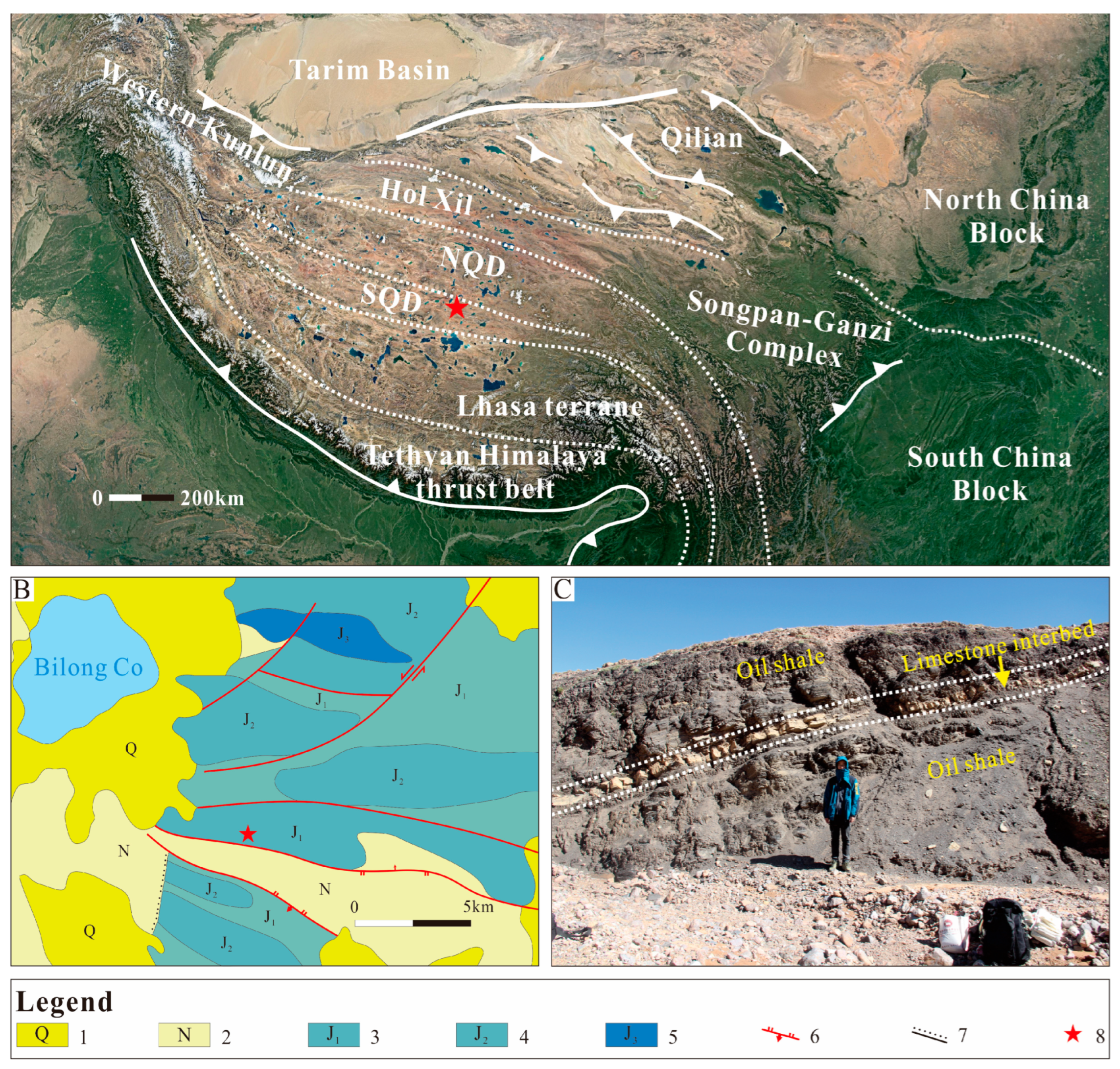
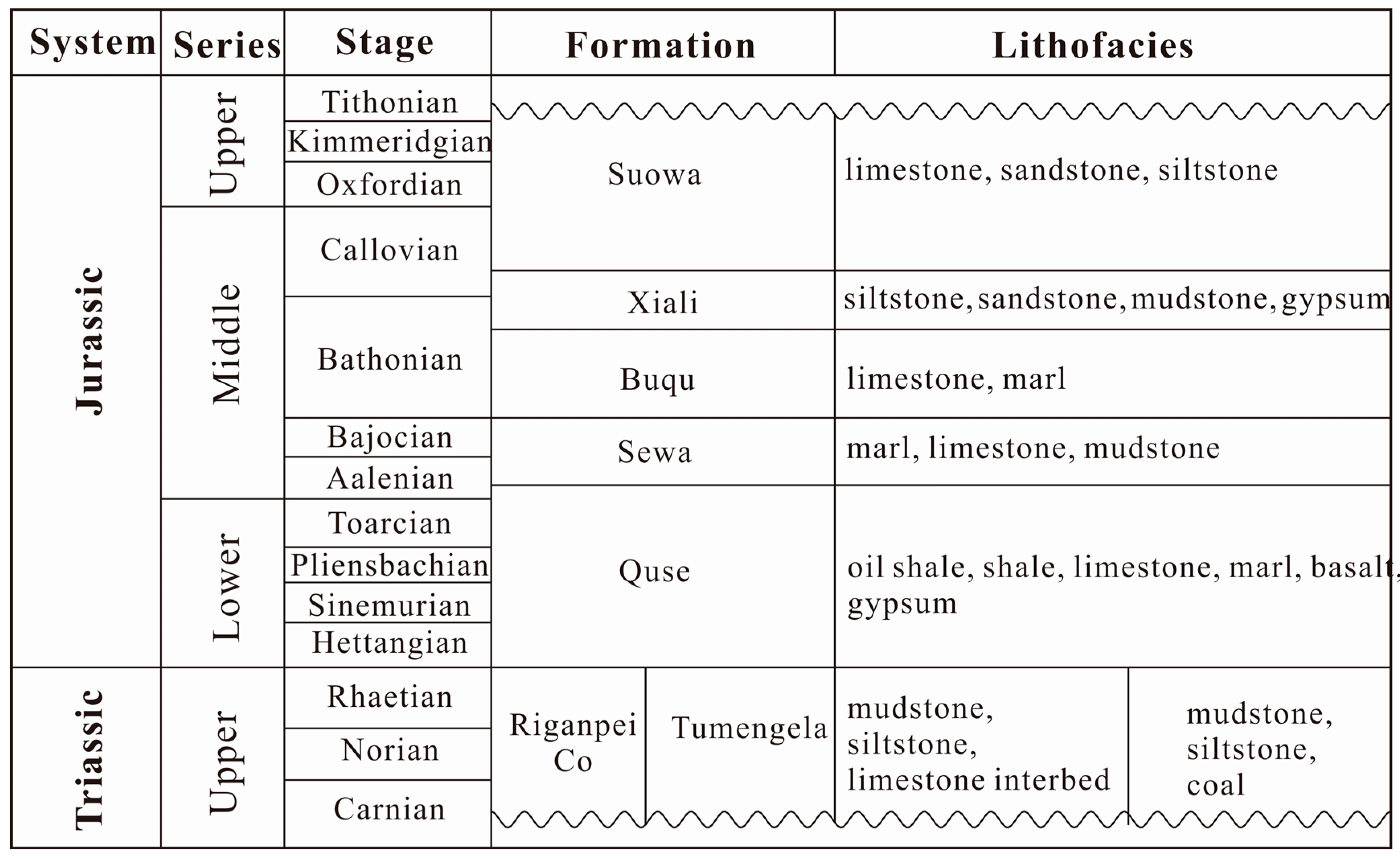
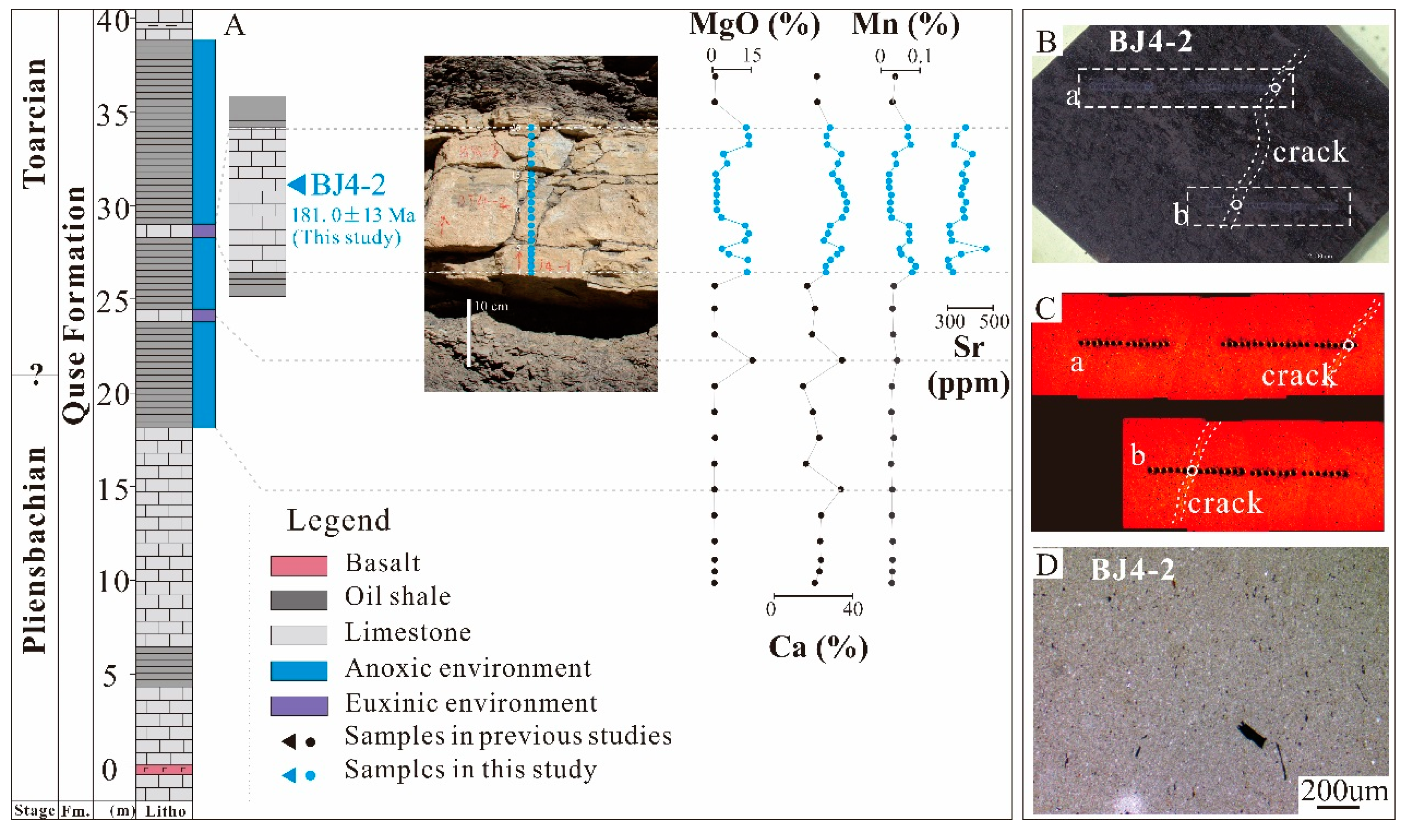
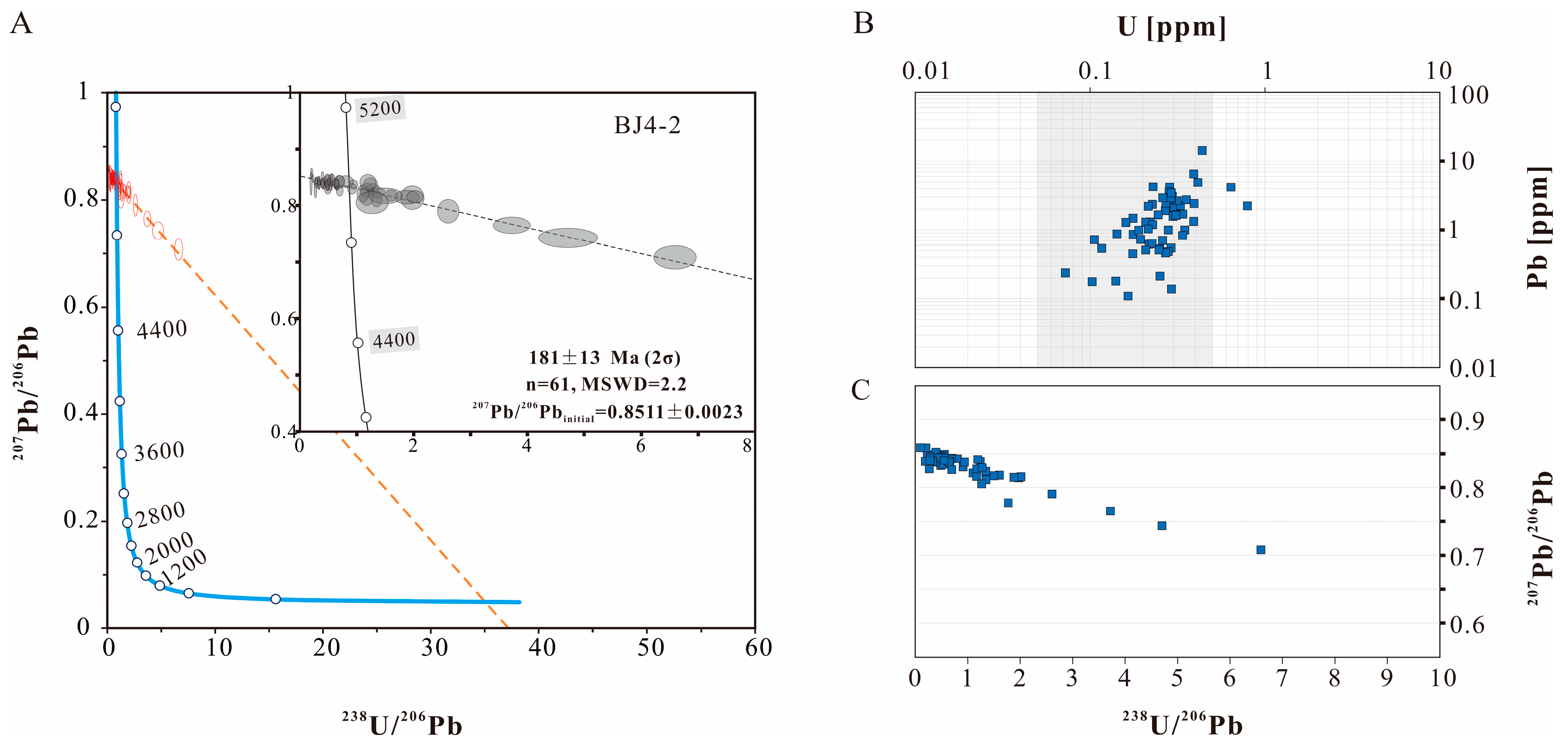
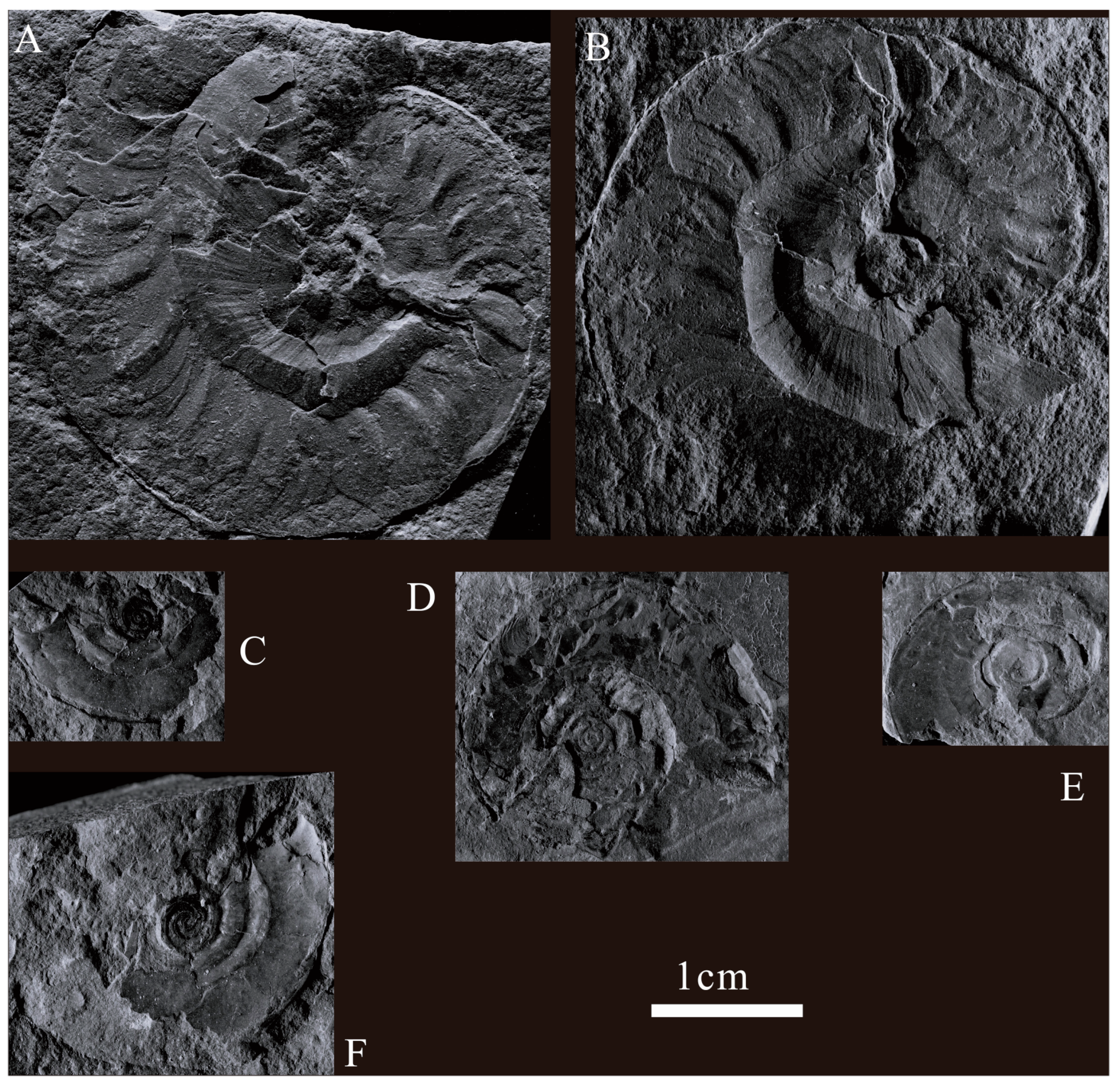
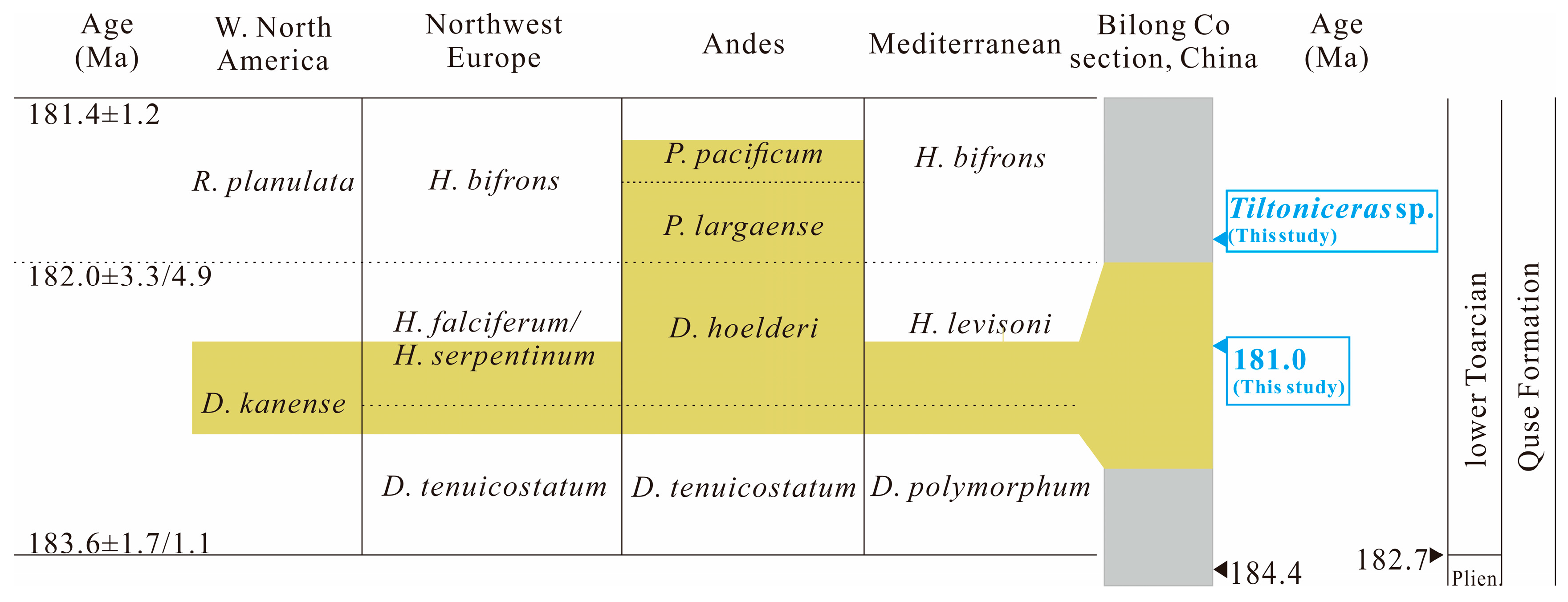
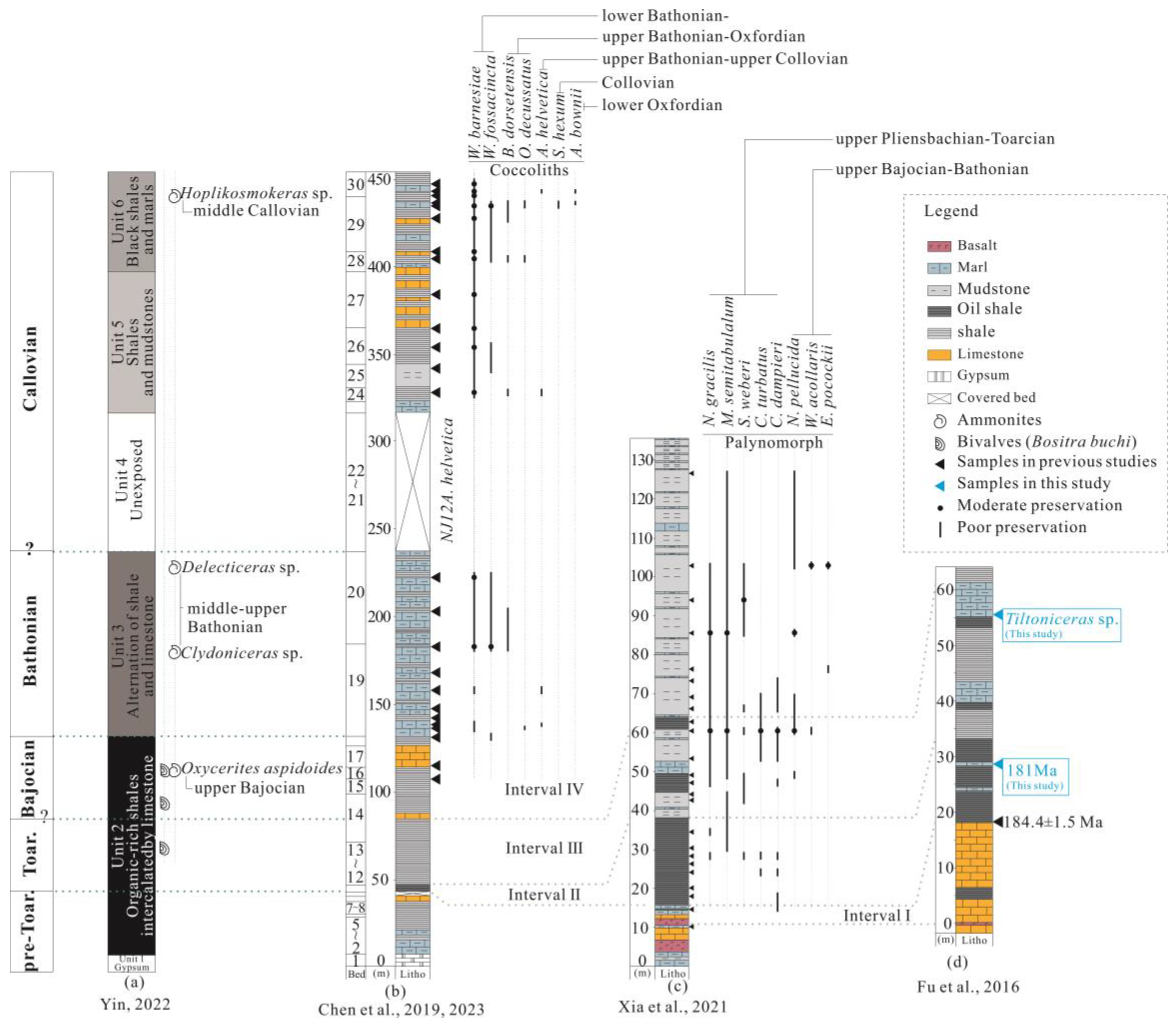
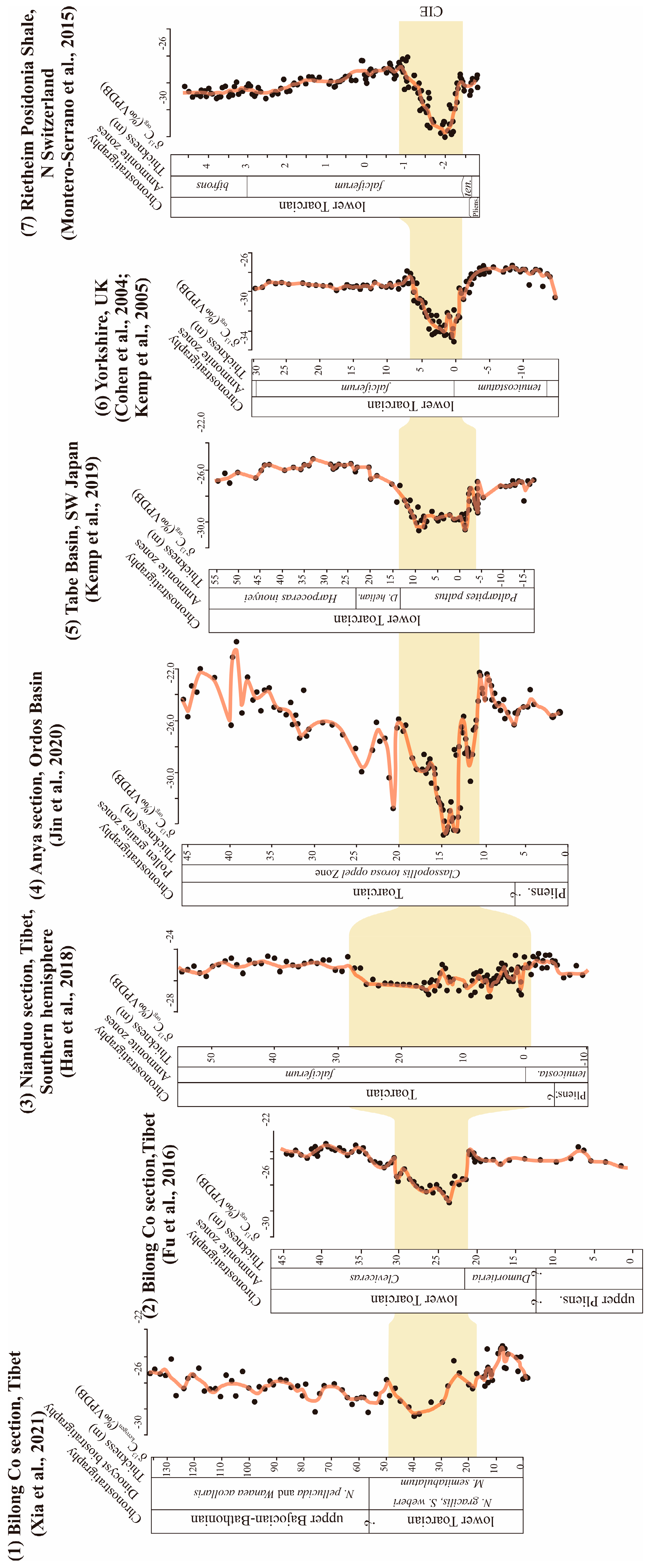
Disclaimer/Publisher’s Note: The statements, opinions and data contained in all publications are solely those of the individual author(s) and contributor(s) and not of MDPI and/or the editor(s). MDPI and/or the editor(s) disclaim responsibility for any injury to people or property resulting from any ideas, methods, instructions or products referred to in the content. |
© 2024 by the authors. Licensee MDPI, Basel, Switzerland. This article is an open access article distributed under the terms and conditions of the Creative Commons Attribution (CC BY) license (https://creativecommons.org/licenses/by/4.0/).
Share and Cite
Zhang, H.; Wang, J.; Mansour, A.; Zhang, J.; Wei, H.; Fu, X.; Shen, L.; Xiong, S.; Ahmed, M.S.; Gentzis, T. New Age Constraints of the Bilong Co Oil Shale in the Qiangtang Basin, Northern Tibet: Evidence from In Situ U–Pb Dating and Palaeontology. Minerals 2024, 14, 246. https://doi.org/10.3390/min14030246
Zhang H, Wang J, Mansour A, Zhang J, Wei H, Fu X, Shen L, Xiong S, Ahmed MS, Gentzis T. New Age Constraints of the Bilong Co Oil Shale in the Qiangtang Basin, Northern Tibet: Evidence from In Situ U–Pb Dating and Palaeontology. Minerals. 2024; 14(3):246. https://doi.org/10.3390/min14030246
Chicago/Turabian StyleZhang, Haowei, Jian Wang, Ahmed Mansour, Jianyong Zhang, Hengye Wei, Xiugen Fu, Lijun Shen, Shaoyun Xiong, Mohamed S. Ahmed, and Thomas Gentzis. 2024. "New Age Constraints of the Bilong Co Oil Shale in the Qiangtang Basin, Northern Tibet: Evidence from In Situ U–Pb Dating and Palaeontology" Minerals 14, no. 3: 246. https://doi.org/10.3390/min14030246
APA StyleZhang, H., Wang, J., Mansour, A., Zhang, J., Wei, H., Fu, X., Shen, L., Xiong, S., Ahmed, M. S., & Gentzis, T. (2024). New Age Constraints of the Bilong Co Oil Shale in the Qiangtang Basin, Northern Tibet: Evidence from In Situ U–Pb Dating and Palaeontology. Minerals, 14(3), 246. https://doi.org/10.3390/min14030246






